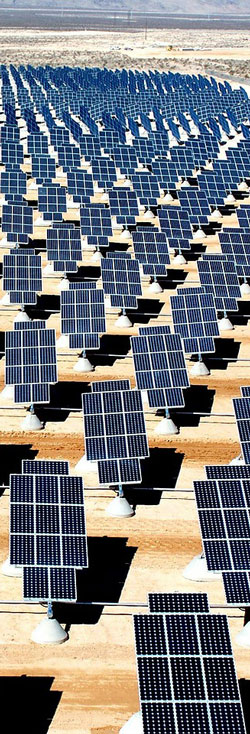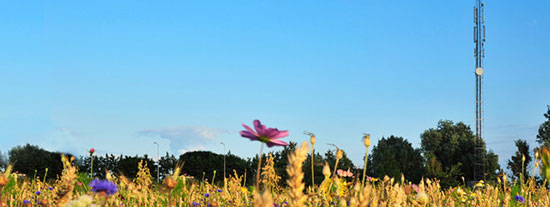connect
people
ANNUAL
REPORT
2016


Cellnex has defined Sustainable Business Development as one of the basic pillars of its CR Master Plan.
 Cellnex has an Environmental Policy based on respecting the environment and protecting and preserving biodiversity through efficient use of resources and by promoting preventive actions.
Cellnex has an Environmental Policy based on respecting the environment and protecting and preserving biodiversity through efficient use of resources and by promoting preventive actions.
So, not only does Cellnex base its activity on the principles of sustainability and responsibility, but has also defined Sustainable Business Development as one of the basic pillars of its CR Master Plan.
This involves the company committing to sustainability, environmental preservation and efficiency by setting goals, and more specifically by implementing concrete actions and programmes for all the companies of the Group.
The goals defined in the Plan as part of the Sustainable Business Development pillar are:
78% of the goals set for 2016 have been implemented and on 31 December 10% of the actions taken were available with measurable results.
Cellnex has a procedure for identifying and assessing environmental aspects and risks related to the company’s business and its derived environmental impacts, as well as the significance criteria.
The most significant impacts are extracted from these assessments and inventoried. The impacts judged to be most critical are selected and incorporated into the company’s management systems. Once incorporated, a monitoring system is established, and plans are devised to manage and mitigate the impacts.
The following management and efficiency plans are implemented according to the type of impact:
Waste
Cellnex manages and recovers 99% of the waste generated on-site.
 Energy
Energy
Cellnex monitors the Group’s energy consumption in order to achieve maximum efficiency and the lowest possible impact on the environment and hence on society.
The company’s electricity consumption in 2016 was 261,915,351 KWh in Spain1 and 215,937,000 kWh in Italy. It should be noted that this year was the first in which Cellnex has incorporated the annual consumption of its companies in Italy and also included the consumption of the sports facilities located at the corporate offices of Cellnex Telecom.
Cellnex Spain has photovoltaic generation facilities and small-scale wind turbines on its sites, which generated 67,910.5 kWh in 2016
1: This electricity consumption refers to the electricity paid for by Cellnex Telecom, which includes both electricity purchased for own consumption (G4-EN3) and that consumed by Cellnex Telecom customers who share their sites with the company. A financial control consolidation approach was considered in the preparation of this indicator.
Cellnex Telecom has been Clean CO2 compensation certified, which accredits its neutrality and the withdrawal of credits from the project selected from the Markit Environmental Registry.
Cellnex has made a great and continuous effort to roll out policies and practices to comply with sustainability and environmental commitments. The Corporate Responsibility Policy and Environmental Policy based on respecting the environment and protecting and preserving biodiversity through the efficient use of resources and promoting preventive actions are good examples of the policies implemented by the company.
One example of this effort is the “Best Newcomer Spain” award received on 25 October 2016 organised by the Carbon Disclosure Project (CDP). CDP is an internationally recognised organisation working towards sustainability and the environment, which assesses both the quality of information and its reporting.
In 2016, Cellnex worked on the development and implementation of a software application called Clean CO2, which calculates and offsets both the corporate carbon footprint of the Group’s companies and the carbon footprint of the services it offers to its customers. This tool, based on the methodologies for calculating the carbon footprint in ISO 14064-1:2012 and the Greenhouse Gas Protocol, aims to introduce the concept of sustainability and carbon management into the services that Cellnex provides to its customers, for the calculation, management, offsetting and notification of the impact on climate change through the use of the services Cellnex provides. Clean CO2 gives the company the capability to offset GHG emissions obtaining the “CO2 Clean certified” label, a document certifying that the service offered to the customer is neutral in terms of GHG emissions.
 In 2016, Cellnex took a step further in its efforts to combat climate change, offsetting Scope 1 GHG emissions from Spain’s 2015 footprint, a total of 2,576 t.CO2e, with the Balikesir Wind Power Plant Project, a high quality GHG emission-reduction project of the voluntary carbon market based in Turkey that brings environmental and social benefits to local communities.
In 2016, Cellnex took a step further in its efforts to combat climate change, offsetting Scope 1 GHG emissions from Spain’s 2015 footprint, a total of 2,576 t.CO2e, with the Balikesir Wind Power Plant Project, a high quality GHG emission-reduction project of the voluntary carbon market based in Turkey that brings environmental and social benefits to local communities.
Cellnex Telecom has been Clean CO2 compensation certified, which accredits its neutrality and the withdrawal of credits from the project selected from the Markit Environmental Registry.

Cellnex Spain’s GHG emissions are calculated taking account of the company’s operational and organisational scope. To that end, the organisational scope was calculated on the basis of the operational control criterion for the corporate premises and technicians of the Cellnex Spain companies: Tradia, Retevisión and OnTower.
Notably, the Carbon Footprint presented has been verified by an independent third party, representing the first year’s audited reporting of Cellnex with regard to Corporate Responsibility.
The operational scope is based on the following criteria:
Cellnex Telecom complies with the rules associated with electromagnetic emissions for the general public and its workers.
In 2016, Cellnex continued to work to obtain procedures and activities to help the company reduce its consumption of energy and natural resources. This objective is attained through two different approaches; one is based on implementing projects in the company’s premises, and the other involves Cellnex’s active participation in research projects seeking to improve efficiency of consumption and reduction of waste generation.
Various efficiency projects were started this year that are significant in terms of the impact they can have on Cellnex’s sustainable management model.
Cellnex manages its facilities to minimise any environmental impact to meet its objective of preserving biodiversity.
As part of the evaluation and monitoring of the aspects and impacts that the organisation could cause on the environment, Cellnex has identified loss of biodiversity and the environmental impact on living beings and natural species as significant in this regard. Cellnex manages its facilities to minimise any environmental impact to meet its objective of preserving biodiversity.
This commitment is embodied in the actions included in the CSR Plan formalised in 2016, through which Cellnex seeks to reduce its environmental impact. This objective can be seen in a management that fosters the highest possible integration of the infrastructure into the surroundings, responsible and efficient management of consumption and waste in all company facilities and preservation of ecosystems affected by the company’s activity.
In Italy 23% of the sites are within protected areas, while in Spain this figure is 57%. Since only maintenance activities could have a potential environmental impact, Cellnex manages these activities through contracting suppliers who apply and guarantee best practices in environmentally safe operations.
Cellnex understands the importance of reducing the visual pollution of its infrastructure and thereby minimising its visual impact. In this connection, the company has been working for several years on antenna installation and modification operations to visually integrate this technology into the surrounding environment.
In Spain, various measures were applied to mitigate visual impacts in 2016. The main actions included dismantling triangles of towers, relocating antennas and mimicry and camouflage projects for panel and facade antennas.
 DaMA
DaMA
Cellnex uses the DaMA (environmental data server) tool to display geographical data and identify declared natural protection sites in the country, information that is also found in the GESEM database. The server also provides access to environmental data relating to Cellnex Spain’s sites.
Cellnex Telecom complies with the rules associated with electromagnetic emissions for the general public and its workers. It conducts periodic measurements at technical centres with a permanent staff presence. As regards the general public, it ensures compliance with Royal Decree 1066/2001 at all sites.
The current situation in Italy involves a stricter regulatory framework, with limitation levels lower in Spain. Likewise, Cellnex Italy is working towards ensuring compliance.
GRI: G4-26, G4-27, G4-EN12, G4-EN27,PA.9, G4-DMA, G4-EN1, G4-EN3, G4-EN4, G4-EN5, G4-EN6, G4-EN7, G4-EN11, G4-EN15, G4-EN16, G4-EN17, G4-EN18,G4-EN19
We use our own and third-party cookies to improve our services and show you advertising related to your preferences by analysing your browsing habits. If you continue to browse, we understand that you accept the use of these cookies. You can change your configuration or obtain further information Cookies Policy. Accept